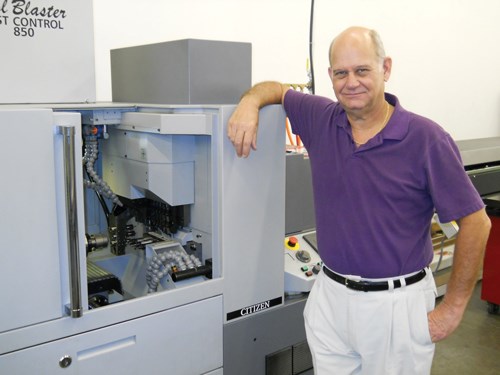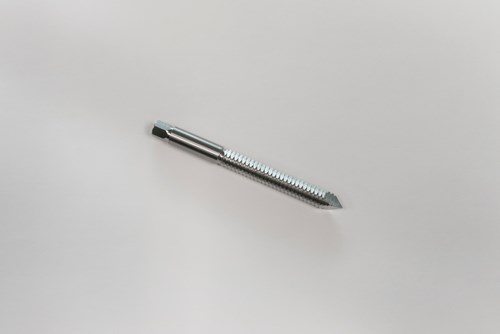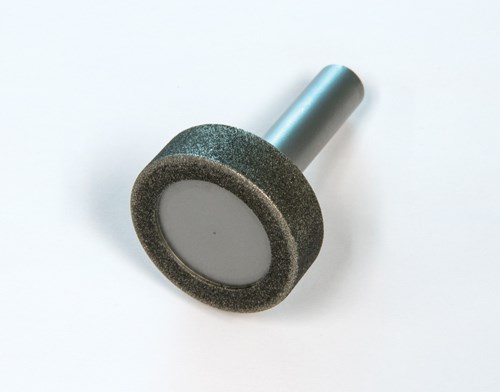Grinding on a Swiss
This shop owner has developed a unique, and effective, approach to delivering a burr-free, tight-tolerance part.
It’s a small shop in Naples, Fla., but MicroSwiss isn’t lacking in big ideas. Shop Owner Jeff Bonner says he learned from his father to always be looking for a better way to do things. With the help of his engineering degree, he’s come up with some clever solutions to common shop issues. It shouldn’t come as a surprise, then, that one such product development has helped him double part production with a superior surface finish compared with previous processes. And this one might even be one of those palm-to-the-forehead ideas that make other shop owners say, “Why didn’t I think of that?”
MicroSwiss focuses on medical device manufacturing. Mr. Bonner previously worked at one major medical supplier, and when some of his co-workers moved on to another company, he opened his contract shop to meet their requests. Originally established in Memphis, the shop has since moved to Naples and currently runs one Citizen A20 and three L20 CNC Swiss lathes.
As with most job shops, MicroSwiss lives and dies by the ability to provide more parts with better quality and efficiency. So Mr. Bonner sees great value in his knack for developing unique ideas for delivering on challenging parts.
Seeing a Need
A few years ago, a customer approached Mr. Bonner with a new part to quote. The company had been machining the part in-house with limited success and needed to find a more efficient solution that could provide the necessary finish.
The part is a piece of stainless steel wire about 0.100 inch in diameter with several flats machined onto the outside diameter. Each of the flats is 1-inch long. They intersect each other as well as other features on the part. The method that was being used to produce the part employed end mills and a support to hold the part while it was being machined.
The customer’s requirements for the part were clearly specified: “The part must have a very good finish on the machined surfaces, the tight tolerance across and along all of the features must be held, and the finished part must be burr free.”
Mr. Bonner’s immediate reaction was to consider the use of a grinding wheel in one of MicroSwiss’s Swiss-type screw machines. “The shape and size of the part is ideally suited to be run in this type of machine,” he says. “And the process needed to be very efficient, with the customer requiring tens of thousands of parts in a very short period of time.”
But screw machines are not designed to handle grinding operations. The horsepower required to drive a grinding wheel is much higher than what is available on most Swiss screw machines. For this reason, the process would work best on small-diameter stock and on larger stock where a light finishing cut is used. The depth of cut and feed rate are functions of the horsepower available at the live tool, which varies from one machine to another. Another variation from typical Swiss operations is that grinding operations produce swarf instead of chips. If the swarf is not removed, it can clog the coolant system over time and have an adverse effect on part finish. A coolant filtration system is an important component in helping to minimize these issues. (Many high pressure coolant systems already have a filter built in.)
Product Development
Regardless of the potential drawbacks, Mr. Bonner still viewed grinding as the best possible solution to meeting the customer’s needs. But he had not yet addressed the toughest issue, which involved meeting the surface speed requirements of grinding operations. The available live tool rpm on Swiss screw machines is typically in the 5,000-rpm range. His screw machines can handle a maximum cutting tool diameter of 30 mm (1.181 inches). Spinning the 30-mm tool at maximum rpm would produce only about 1,550 sfpm, while conventional wisdom says that most grinding operations require a minimum of about 3,000 sfpm.
Not one to give up, Mr. Bonner designed a grinding wheel with a 10-mm shank and a 30-mm head diameter to provide the maximum possible cutter speed. It included a relief on the bottom of the wheel and a minimum radius on the leading edge (corner). He contacted a specialty tool company to produce the prototype grinding wheel and was told that the wheel would probably not last very long, even at the machine’s maximum RPM. Despite the manufacturer’s advice, he tried it anyway and was able to make 160 good parts before the wheel failed. He then modified the design of the wheel and had it produced with a larger radius on the working corner. It could now produce 6,000 parts—quite an improvement, but Mr. Bonner still was not satisfied.
He followed up with another increase in the radius, but also incorporated a precision collet in the live toolholder and put new bearings in the live toolholder. With these changes, a single grinding wheel could now produce 30,000 parts. The finish was excellent, the size was well within tolerance, and the parts had no burrs. “Not bad for a process that was not supposed to work,” Mr. Bonner says. “It is important that the live tooling bearings are not worn, and the 0.020-inch (0.5-mm) radius makes a big difference. Now the part runs 24 hours a day, 6 ½ days a week.” Mr. Bonner has filed for a patent on the technology, and it is currently pending with potential publishing in the spring of 2013.
Application
The cutting tool is designed to be mounted into the OEM live toolholder and run at maximum rpm. Mr. Bonner explains that the process works best on alloy steels, and he does not recommend using it with soft metals such as brass and aluminum because they will load up the wheel. He is currently testing exotic material, such as titanium, and expects to have a grinding wheel that will work with such materials in the future.
Grinding on a Swiss offers several advantages over milling.
- Grinding is a continuous cutting process, which can provide a better finish than milling’s interrupted cutting process, which induces vibration into the part being machined.
- Grinding processes operate at a much higher sfpm than milling. This higher sfpm allows the continuous cutting action to be performed at a higher feed rate while still producing a fine finish. Higher feed rates equal shorter production cycles and increased productivity.
- Milling cutters operate at a potentially undesirable distance from the face of the guide bushing. The grinding wheel operates at the face of the guide bushing in line with the front turning tool, which is typically about 1 mm from the guide bushing face. Operating this close to the guide bushing eliminates the need for a support common to some milling operations. This method produces a part with minimal taper and excellent size control.
- The tool never needs to be dressed and runs until failure, at which time the tool is simply replaced. Because the grinding wheel does not wear as the tool is being used, none of the grinding abrasive gets into the coolant system.
- This grinding process does not produce undesirable burrs on the part, which is particularly important on parts that have overlapping features. A typical example would be an OD thread with a flat machined on the top of the thread. If a milling cutter is used to mill the flat, the burr will go down into the thread and require a deburring operation. The grinding operation produces the flat feature with no burrs pushed into the thread. The part is produced in a shorter amount of time with no secondary operations to remove the burr.
This Swiss grinding technology can also be used in certain applications to replace turning operations. Some materials are very difficult to machine because of their hardness or toughness. In a production environment, carbide turning inserts have a short life when cutting these materials. The abrasive particle used in these grinding tools, however, is not affected by these hard/tough materials.
The grinding/machining procedure is to rotate the grinding wheel at maximum rpm, counter-rotate the material to be machined at high rpm, and move the grinding wheel along the same path that the turning tool would have taken. This process is similar to turn-milling except that a grinding wheel is used instead of a milling cutter. The grinding process is also faster.
On the Horizon
Because of the success Mr. Bonner has experienced with his Swiss grinding process, he is making the tool available to other shops. This process has been developed to work
on alloy steel materials such as stainless steel. Testing is in process on exotic materials such as titanium, and Mr. Bonner expects them to be available soon, as well.
The list of varying grinding wheel profiles is also growing. A wheel with extreme bottom relief will be offered to allow customers to grind profiles such as ball-style hex drivers and unusual profiles.
Mr. Bonner says, “Possibly the most exciting new product will allow the customer to grind bone screw profiles as an alternative to thread whirling.” The goal is to develop a grinding wheel with the thread profile in the wheel that can be mounted into a standard face drilling live toolholder.
This technology is not meant to replace all milling operations; the way the tool is used does not allow for this. Some features such as pockets cannot be machined with this style of cutter and will still need to be milled. “This technology is another tool that the machinist has in his toolbox to improve part quality and reduce cycle time when the part shape allows for its use,” Mr. Bonner says.
— Marubeni Citizen-Cincom Inc.
Related Content
Automation in the Alps: Studer AG Unveils New Grinding Concepts
Studer AG, member company of United Grinding, held its annual press conference at its Swiss Alps location earlier this month to announce its new automatic loaders to accompany its existing grinding machines as well as other offerings and automation features.
Read MoreStuder S100 Grinding Machine For High-Precision, Flexible, Reliable Grinding
The machine is well suited for a wide range of internal, surface and external grinding applications, making it well suited for the entry-level market.
Read MoreANCA Grinding Platform Boosts Tool Grinding Productivity
The MX7 platform supports the grinding of various tool shapes in a single setup, eliminating the need for wheel changes.
Read MoreGrinding Options for Dental Burrs and Rotary Instruments
Equipment to grind dental burrs continues to evolve. Here are five options for grinding these types of workpieces.
Read MoreRead Next
No Touch Up Needed For ER Collet Tools
Downtime, long setup times and hiring skilled employees for night shifts are some of the problems every shop has. In its shop, American Torch Tip has completely integrated the quick-change tool system and drastically reduced those problems by developing a system that will go in any ER-style holder. Tools can now be preset off the machine, during the first shift and while the machines are running.
Read MoreA Tooling Workshop Worth a Visit
Marubeni Citizen-Cincom’s tooling and accessory workshop offers a chance to learn more about ancillary devices that can boost machining efficiency and capability.
Read MoreEmerging Leaders Nominations Now Open
Here’s your chance to highlight a young person in your manufacturing business who is on the path to be a future leader moving your company forward.
Read More

















.jpg;maxWidth=300;quality=90)








